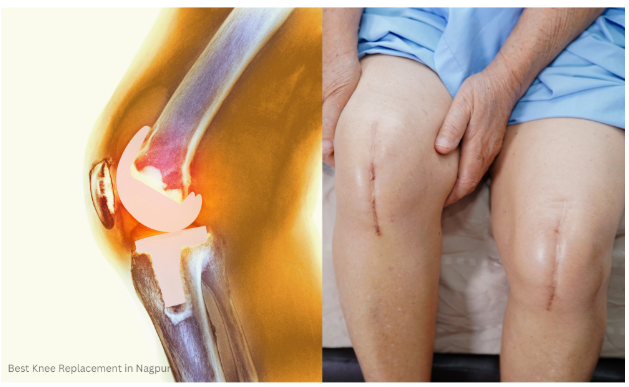Best Knee Replacement in Nagpur

Best Knee Replacement: Anatomy, Cause, Description, and Orthopedic Analysis
Knee replacement surgery, referred to as knee arthroplasty, has emerged as one of the most prevalent and effective orthopedic interventions globally. This procedure alleviates chronic knee pain for patients and aids in the restoration of mobility, allowing individuals to enjoy an active and pain-free lifestyle. In this article, we will explore the anatomy of the knee, the factors contributing to knee damage, a detailed overview of knee replacement surgery, and an orthopedic evaluation of this transformative procedure. For those in search of optimal knee replacement solutions, this guide aims to offer valuable information and understanding.
Anatomy of the Knee Joint
The knee is among the largest and most intricate joints within the human body. It functions as a hinge, facilitating the flexion and extension of the leg while supporting the body’s weight.
The knee joint is primarily composed of three main structures:
- Femur (Thigh Bone): The superior bone of the knee joint.
- Tibia (Shin Bone): The inferior bone of the knee joint.
- Patella (Kneecap): A small, triangular bone that safeguards the anterior aspect of the joint.
Articular cartilage serves as a cushion for these bones, minimizing friction and facilitating smooth movement within the joint. Additionally, the knee joint is reinforced by ligaments, tendons, and menisci, which contribute to its stability and ability to absorb shock.
Causes of Knee Joint Damage
Various elements may lead to the decline of the knee joint, ultimately resulting in the necessity for optimal knee replacement options.
- Osteoarthritis: This condition is the leading cause of joint pain, marked by the progressive deterioration of cartilage within the joints.
- Rheumatoid Arthritis: This is an autoimmune condition that leads to inflammation and harm to the synovial membrane of the joints.
- Post-Traumatic Arthritis: This type of arthritis develops following injuries, including fractures or tears in ligaments.
- Obesity: Increased body weight exerts additional pressure on the knee joints.
- Genetic Factors: Certain individuals may have a genetic predisposition to developing joint problems.
Description of Knee Replacement Surgery
The most effective knee replacement surgeries entail the substitution of the damaged or deteriorated elements of the knee joint with artificial implants composed of metal and plastic materials.
This surgical intervention can be classified into two distinct types:
- Total Knee Replacement (TKR): The entire knee joint is replaced with prosthetic component
- Partial Knee Replacement (PKR): Only the affected segment of the joint is substituted.
The procedure generally lasts between one to two hours and is conducted under either regional or general anesthesia. Following the surgery, engaging in physical therapy is crucial for restoring strength, flexibility, and mobility.
Orthopedic Analysis: Is Knee Replacement Right for You?
Orthopedic specialists conduct a comprehensive evaluation to ascertain whether knee replacement is the most suitable option for a patient. The factors taken into account include:
- Intensity of Discomfort and Movement Limitations: Ongoing pain and restricted mobility despite non-invasive treatment options.
- Radiographic and Imaging Findings: Indications of cartilage deterioration or joint misalignment.
- Patient’s Age and Health Status: General health and potential for recovery following surgical intervention.
- Lifestyle Aspirations: Targeted activity levels anticipated post-surgery.